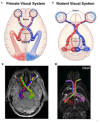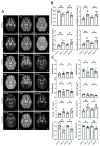Advanced Diffusion MRI of the Visual System in Glaucoma: From Experimental Animal Models to Humans
- PMID: 35336827
- PMCID: PMC8945790
- DOI: 10.3390/biology11030454
Advanced Diffusion MRI of the Visual System in Glaucoma: From Experimental Animal Models to Humans
Abstract
Glaucoma is a group of ophthalmologic conditions characterized by progressive retinal ganglion cell death, optic nerve degeneration, and irreversible vision loss. While intraocular pressure is the only clinically modifiable risk factor, glaucoma may continue to progress at controlled intraocular pressure, indicating other major factors in contributing to the disease mechanisms. Recent studies demonstrated the feasibility of advanced diffusion magnetic resonance imaging (dMRI) in visualizing the microstructural integrity of the visual system, opening new possibilities for non-invasive characterization of glaucomatous brain changes for guiding earlier and targeted intervention besides intraocular pressure lowering. In this review, we discuss dMRI methods currently used in visual system investigations, focusing on the eye, optic nerve, optic tract, subcortical visual brain nuclei, optic radiations, and visual cortex. We evaluate how conventional diffusion tensor imaging, higher-order diffusion kurtosis imaging, and other extended dMRI techniques can assess the neuronal and glial integrity of the visual system in both humans and experimental animal models of glaucoma, among other optic neuropathies or neurodegenerative diseases. We also compare the pros and cons of these methods against other imaging modalities. A growing body of dMRI research indicates that this modality holds promise in characterizing early glaucomatous changes in the visual system, determining the disease severity, and identifying potential neurotherapeutic targets, offering more options to slow glaucoma progression and to reduce the prevalence of this world's leading cause of irreversible but preventable blindness.
Keywords: diffusion; eye; glaucoma; magnetic resonance imaging; optic nerve; visual pathway.
Conflict of interest statement
The authors declare no conflict of interest.
Figures










Similar articles
-
Application of advanced diffusion MRI based tractometry of the visual pathway in glaucoma: a systematic review.Front Neurosci. 2025 May 21;19:1577991. doi: 10.3389/fnins.2025.1577991. eCollection 2025. Front Neurosci. 2025. PMID: 40470296 Free PMC article.
-
[Aiming for zero blindness].Nippon Ganka Gakkai Zasshi. 2015 Mar;119(3):168-93; discussion 194. Nippon Ganka Gakkai Zasshi. 2015. PMID: 25854109 Review. Japanese.
-
Citicoline Modulates Glaucomatous Neurodegeneration Through Intraocular Pressure-Independent Control.Neurotherapeutics. 2021 Apr;18(2):1339-1359. doi: 10.1007/s13311-021-01033-6. Epub 2021 Apr 13. Neurotherapeutics. 2021. PMID: 33846961 Free PMC article.
-
In vivo imaging of structural, metabolic and functional brain changes in glaucoma.Neural Regen Res. 2019 Mar;14(3):446-449. doi: 10.4103/1673-5374.243712. Neural Regen Res. 2019. PMID: 30539811 Free PMC article. Review.
-
Diffusion Kurtosis Imaging Reveals Optic Tract Damage That Correlates with Clinical Severity in Glaucoma.Annu Int Conf IEEE Eng Med Biol Soc. 2020 Jul;2020:1746-1749. doi: 10.1109/EMBC44109.2020.9176192. Annu Int Conf IEEE Eng Med Biol Soc. 2020. PMID: 33018335 Free PMC article.
Cited by
-
Association Between Glaucoma and Brain Structural Connectivity Based on Diffusion Tensor Tractography: A Bidirectional Mendelian Randomization Study.Brain Sci. 2024 Oct 17;14(10):1030. doi: 10.3390/brainsci14101030. Brain Sci. 2024. PMID: 39452042 Free PMC article.
-
Diffusion tensor imaging of optic neuropathies: a narrative review.Quant Imaging Med Surg. 2024 Jan 3;14(1):1086-1107. doi: 10.21037/qims-23-779. Epub 2024 Jan 2. Quant Imaging Med Surg. 2024. PMID: 38223128 Free PMC article. Review.
-
Altered stability of dynamic brain functional architecture in primary open-angle glaucoma: a surface-based resting-state fMRI study.Brain Imaging Behav. 2024 Feb;18(1):44-56. doi: 10.1007/s11682-023-00800-7. Epub 2023 Oct 19. Brain Imaging Behav. 2024. PMID: 37857914 Free PMC article.
-
Convolutional neural network-based classification of glaucoma using optic radiation tissue properties.Commun Med (Lond). 2024 Apr 11;4(1):72. doi: 10.1038/s43856-024-00496-w. Commun Med (Lond). 2024. PMID: 38605245 Free PMC article.
-
Contributions of Brain Microstructures and Metabolism to Visual Field Loss Patterns in Glaucoma Using Archetypal and Information Gain Analyses.Invest Ophthalmol Vis Sci. 2024 Jul 1;65(8):15. doi: 10.1167/iovs.65.8.15. Invest Ophthalmol Vis Sci. 2024. PMID: 38975942 Free PMC article.
References
Publication types
Grants and funding
LinkOut - more resources
Full Text Sources
Miscellaneous

